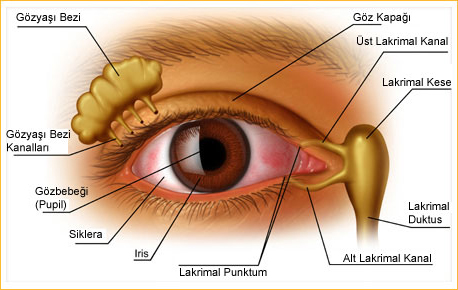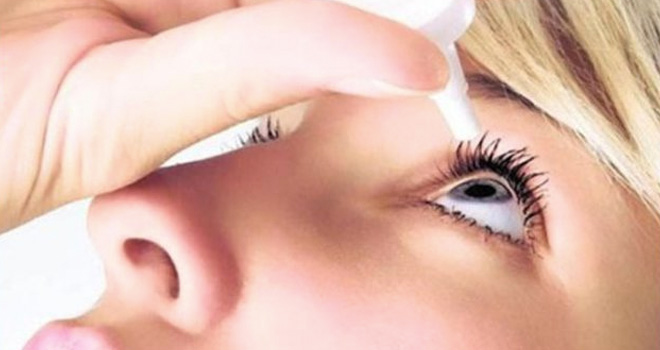Dry Eye

Healthy eyes are continuously covered by a tear film designed to remain stable between blinks. A stable tear film prevents dry eyes and allows your eyes to maintain clear, comfortable vision. Decreased production of fluids from tear glands can destabilize the tear film, allowing it to break down rapidly and create dry spots on the surface of the eyes. An imbalance in the substances that make up the tear film also causes dry eyes.
Tears are essential for good eye health.They bathe the eye, wash out dust and debris and keep the eye moist. Tears also contain enzymes that neutralize the microorganisms that colonize the eye.
Tears are comprised of three layers. The mucus layer coats the cornea, the eye’s clear outer window, forming a foundation so the tear film can adhere to the eye. The middle aqueous layer provides moisture and supplies oxygen and other important nutrients to the cornea. This layer is made of 98 percent water along with small amounts of salt, proteins and other compounds. The outer lipid layer is an oily film that seals the tear film on the eye and helps to prevent evaporation.
 In dry eye syndrome, the eye doesn't produce enough tears, or the tears have a chemical composition that causes them to evaporate too quickly.In other words, dry eyes are caused by either a deficiency in the quantity or the quality of the tears or tear film.
In dry eye syndrome, the eye doesn't produce enough tears, or the tears have a chemical composition that causes them to evaporate too quickly.In other words, dry eyes are caused by either a deficiency in the quantity or the quality of the tears or tear film.
One of the most common reasons for dryness is simply the normal aging process. As we grow older, our bodies produce less oil. This is more pronounced in women, who tend to have drier skin then men. The oil deficiency also affects the tear film. Without as much oil to seal the watery layer, the tear film evaporates much faster, leaving dry areas on the cornea. Air conditioning or a dry heating system can dry out the eyes. Another cause is insufficient blinking which occurs during staring at a computer screen all day.
Long-term contact lens wear is another cause; in fact, dry eyes are the most common complaint among contact lens wearers.
Sjogren's syndrome is a systemic disease where dry eyes is observed with dry mouth and inflammation of joints.
Blefaritis is the inflammation of eye lid margins leading to dysfunction of oil producing glands of the eye lids and causing to dry eye.
A wide variety of common medications such as diuretics, beta-blockers, antihistamines, sleeping pills or pain relievers can also cause dry eye picture.
Stinging, burning, scratchiness, stringy mucus, redness and watering eyes are the usual symptoms of dry eye.
Watering eyes from dry eye may sound illogical, but tears are also the eye's response to discomfort. If the tears responsible for maintaining lubrication do not keep the eye wet enough, the eye becomes irritated. Eye irritation prompts the gland that makes tears to release a large volume of tears, overwhelming the tear drainage system. These excess tears then overflow from your eye.

Dry eyes can be diagnosed through a comprehensive eye examination. Patient history to determine any symptoms the patient is experiencing and the presence of any general health problems, medications taken or environmental factors that may be contributing to the dry eye problem.
External examination of the eye, including lid structure and blink dynamics and evaluation of the eyelids and cornea using bright light and magnification are important for diagnosis.
Some tests are used in clinical practice for evaluating dry eye. Tear Break Up Time is a measurement made by observing the rate at which the tear film begins to evaporate and indicates the overall stability of the tear film. Tear Staining is a method of using special dyes to help highlight problems with the surface of the eye and the tear film quality. By placing these eye drops in the tear film the severity of the dryness can more easily be recognized. Tear Film Height is a measurement made with the slit lamp biomicroscope to evaluate tear volume
Schirmer's Test determines whether the eye produces enough tears to keep it moist. A Schirmer Test may be performed by placing a small piece of special paper inside your lower eyelid to measure tear production. It poses no risk to the subject. More than 10 mm of moisture on the filter paper in 5 minutes test result is defined as negative which stands for normal production.
There are several ways to treat dry eye. Eyedrops called artificial tears can help lubricate the eyes.Another approach to keeping the eyes moist is to conserve your eyes' own tears. Tears drain out of the eye through a small channel into the nose. (This is why your nose runs when you cry.) These channels can be blocked either temporarily or permanently so that artificial tears last longer. For this purpose punctal plugs are used.

This works like closing a sink drain with a stopper. These special plugs trap the tears on the eye, keeping it moist. This may be done on a temporary basis with a dissolvable collagen plug, or permanently with a silicone plug.
Last Updated: October 23, 2024



























